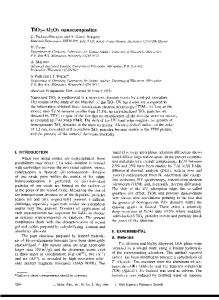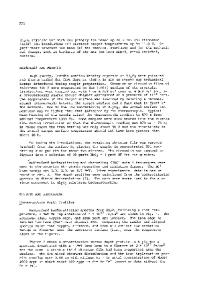The Formation Al 2 O 3 /V 2 O 3 Multilayer Structures by High-Dose Ion Implantation
- PDF / 1,193,401 Bytes
- 6 Pages / 414.72 x 648 pts Page_size
- 41 Downloads / 351 Views
3
MULTILAYER STRUCTURES BY HIGH-DOSE ION IMPLANTATION
LAURENCE A. GEA, L. A. BOATNER, JANET RANKIN*, AND J. D. BUDAI Solid State Division, Oak Ridge National Laboratory, P.O. Box 2008, Oak Ridge, TN 37831, *Brown University, Providence, RI 02912 ABSTRACT High-resolution TEM, RBS-channeling and x-ray-diffraction techniques have been used to characterize multilayered structures formed by the high-dose co-implantation of vanadium and oxygen into single crystals of cx-A1203. Thin, two-dimensional multilayered structures have been formed by implanting c -axis and a -axis-oriented single crystals of A1203 at room temperature with vanadium (1017 ions/cm 2 at 300 keV) and oxygen (2 X 1017 ions/cm 2 , 120 keV) followed by a rapid anneal at 1000'C. Cross-sectional TEM studies showed that this process produced a buried layer of V2 0 3 located about 120 nm below the A12 0 3 surface. X-raydiffraction investigations revealed that this layer is epitaxially oriented in three dimensions with respect to the host A120 3 lattice. The orientational relationship was subsequently confirmed by RBS/channeling techniques. V20 3 exhibits a first-order phase transition at about 155 K that is accompanied by striking changes in its electrical and optical properties, and this phase transition was observed through in-situ TEM cooling studies of cross-sectional samples. 1. INTRODUCTION Vanadium sesquioxide V20 3 , undergoes a thermally-induced crystallographic phase transition that is accompanied by large changes in its electrical and optical properties [1,2] at a temperature of about 155 K. The temperature of the phase-transition may vary depending on the form of V20 3 (e.g. bulk crystal or film) and on the processing method employed in the growth of thin films [3]. V2 0 3 has a narrow homogeneity range [4]. It is monoclinic below the phase transition temperature and has the pseudo-hexagonal corundum structure above the transition temperature. It has been previously shown by the present authors that it is possible to form buried V2 0 3 precipitates in A12 0 3 by high-dose co-implantation of vanadium and oxygen followed by rapid thermal annealing [5]. This process has been shown to result in the production of V203 precipitates that are crystallographically coherent with respect to the host A12 0 3 lattice thus allowing the formation of A12 0 3 /V2 0 3 multilayer systems. However, due to the excess of implanted oxygen (oxygen fluence / vanadium fluence = 2) and the rapid thermal annealing (room temperature to 1000 'C in less than 2 mins.), the resulting crystal surfaces were not of good quality. Here we report the formation of similar multilayer structures that are characterized by an improved surface quality. Furthermore, the effect of the crystallographic orientation of the sapphire substrate on the formation of such layers is investigated. The results of TEM investigations of the implantation-produced structures that are present both below and above the phase transition temperature are also described. 2. EXPERIMENTAL The V and 0 co-implantatio
Data Loading...











